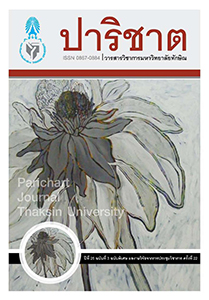ผลกระทบของดัชนีชี้นำทางเศรษฐกิจโลกต่อ อัตราแลกเปลี่ยนของประเทศในกลุ่มอาเซียน
Main Article Content
Abstract
การศึกษาครั้งนี้ได้ทดสอบบทบาทของราคาน้ำมัน ราคาทองคำ และดัชนีหลักทรัพย์ Down Jones ซึ่งเป็นดัชนีชี้นำทางเศรษฐกิจโลกต่ออัตราแลกเปลี่ยนของประเทศในกลุ่มอาเซียน ได้แก่ เปโซ ริงกิต สิงโปร์ดอลลาร์ และบาท โดยใช้ข้อมูลรายวันระหว่างวันที่ 1 มกราคม พ.ศ.2553 ถึง 27 กรกฎาคม พ.ศ. 2554 ทำการเปรียบเทียบระหว่างแบบจำลอง OLS และแบบจำลองการปรับตัวระยะสั้น (Error Correction Model; ECM) ผลการศึกษาพบว่า ทั้ง 3 ดัชนีชี้วัดมีอิทธิพลในทิศทางตรงข้ามกับทุกอัตรา แลกเปลี่ยน ราคาน้ำมันมีบทบาทมากที่สุดต่อสิงคโปร์ดอลลาร์ ริงกิต เปโซ และไทยบาท ราคาทองคำ มีบทบาทมากที่สุดต่อสิงคโปร์ดอลลาร์ เปโซ ริงกิต และไทยบาท และดัชนี Down Jones มีบทบาท มากที่สุดต่อเปโซ ริงกิต สิงคโปร์ดอลลาร์ และไทยบาท จากแบบจำลอง ECM พบว่า อัตราแลกเปลี่ยน สิงคโปร์ดอลลาร์ เปโซ ริงกิต และบาทมีความเร็วในการปรับตัวเข้าสู่ดุลยภาพเท่ากับ 0.073 0.064 0.052 และ 0.009 ตามลำดับ
The Impacts of World Economic Indicators on the ASEAN Exchange Rate
This study aims to test role of world’s economic leading indices namely oil prices, gold prices and Down Jones index to exchange rate of ASEAN, Peso of Philippines, Ringgit of Malaysia, Singapore Dollar and Baht of Thailand. The comparison between OLS and Error Correction Model (ECM) estimation were made. The study found that oil prices have negative strongly influence to Singapore Dollar, Ringgits, Peso, and Thai Baht respectively. Slightly different from oil price, magnitude of impact of gold price to the currencies are Singapore Dollar, Peso, Ringgit and Thai Baht respectively. The impacts of Down Jones index also affect in the opposite direction to Peso, Ringgit, Singapore Dollar and Thai Baht. Finally, using ECM estimation speed of adjustment from short run deviation from long run equilibrium is 0.073 for Singapore Dollar, 0.064 for Peso, 0.052 for Ringgit and 0.009 for Thai Baht.


